If you want to understand what makes the Kiwi bird an extraordinary species, you’ve come to the right place. This flightless wonder, unique to New Zealand, surprises with its nocturnal habits, remarkable size—it heaves the largest egg in proportion to the body size of any bird—and its status as a national icon. This article explores the Kiwi bird’s intriguing characteristics, from its unusual biology to its critical conservation status and cultural importance.
Key Takeaways
Kiwi birds possess unique physical features, such as fuzzy feathers, a long curved bill with nostrils at the tip, and a flightless nature. They also display clear sexual dimorphism with larger, heavier females.
Kiwi birds exhibit diverse behaviors like nocturnal foraging, using a keen sense of smell and complex vocalizations for communication and territory marking, and adapting their diets and shelters to their environments.
Conservation efforts, including predator control and initiatives like Operation Nest Egg, have played a critical role in the survival of Kiwi birds. New Zealand is actively engaged in safeguarding these national symbols.
The Kiwi’s Distinctive Features
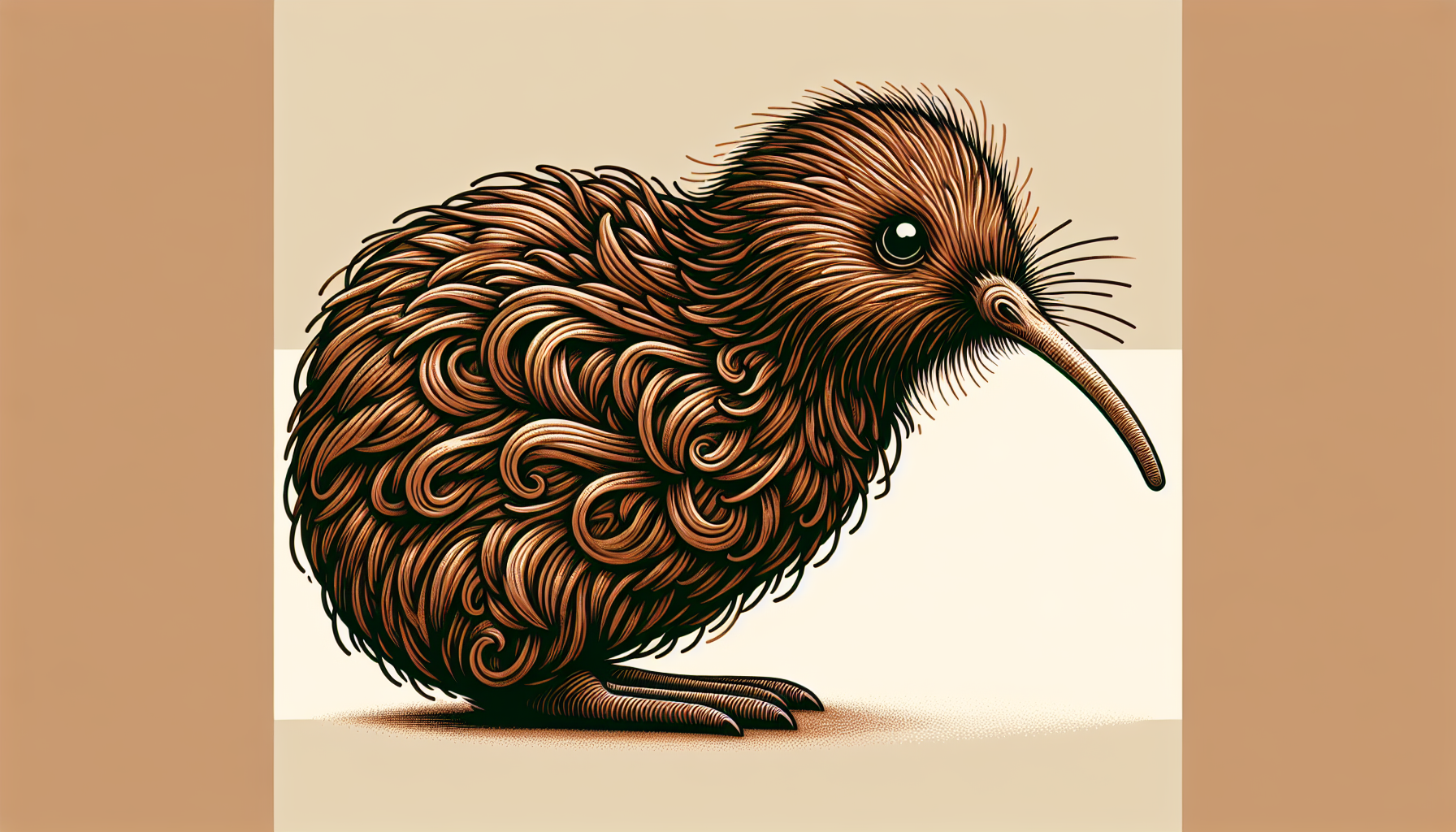
Wandering through New Zealand’s thick woodlands, it’s easy to mistake the flightless Kiwi for a small land-dwelling creature. Their feathery coat is unusually shaggy, and their distinctive long, curved beak sets them apart from the bird family. The positioning of nostrils at the bill’s end grants kiwis an exceptional sense of smell that assists in night-time foraging – a rare feature among birds. As ratites (a group of large, flightless birds), they exhibit only wing remnants, highlighting their earthbound existence. Indeed, the brown Kiwi boasts unique features that set it apart as the only bird with these particular adaptations in New Zealand.
The list below details five separate species within this genus:
Brown Kiwi
Spotted Kiwi
Southern Brown Kiwi
Great Spotted Kiwi
Although part of one genus, each type shows distinctiveness, enhancing New Zealand’s natural diversity.
Size and Sexual Dimorphism
In Kiwi society, female birds outshine males in stature. They display a pronounced sexual dimorphism: Females tip the scales at a greater weight and flaunt more substantial bill lengths. Picture this: a stately female brown kiwi stands approximately 20 inches tall, with her bill reaching an impressive 4.7 inches, overshadowing her male counterpart, who measures about 18 inches in height and whose bill extends merely around 4.1 inches. The contrast in size between male and female Kiwis captures one’s attention due to its distinctiveness.
This disparity in body size isn’t merely cosmetic. The female’s larger physique and extended beak are essential elements of the mating process. Their significant functions enrich our insights into how gender roles shape natural phenomena within bird species such as Kiwis, adding depth to our appreciation of nature’s avian wonders.
Diverse Habitats and Adaptations
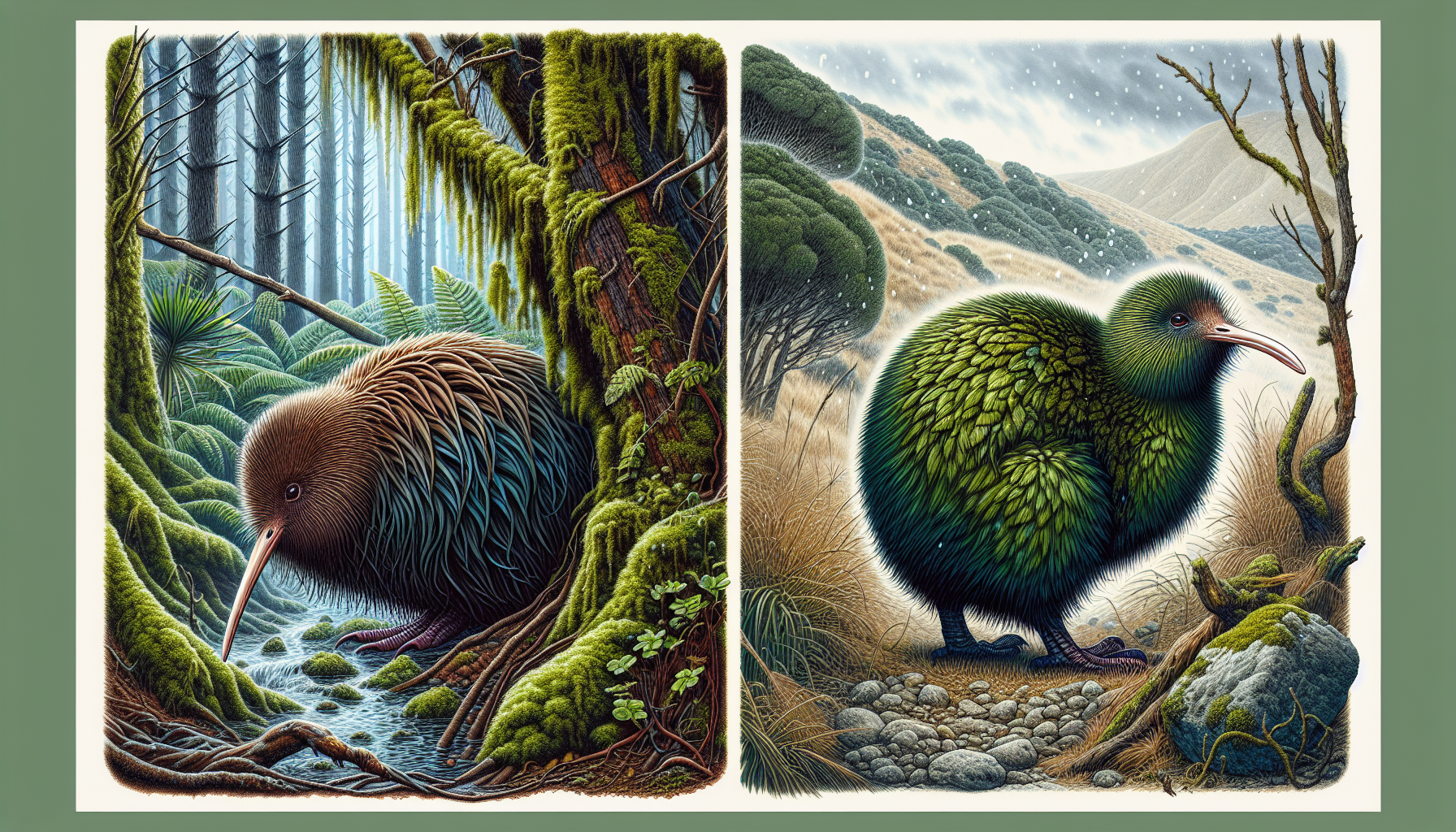
Kiwi birds thrive through remarkable adaptability in habitats ranging from humid forests peppered with towering kauri trees and lush tree ferns to more arid landscapes. These wingless avians have evolved diverse survival strategies in response to their environments. One key adaptation is seen in their feeding behavior. Where water is a rarity, these birds rely on consuming food with moisture content. Earthworms are particularly favored by Kiwis, consisting of approximately 85% water, thus providing these flightless birds with essential hydration.
Kiwi’s versatility also extends to its selection of habitation spaces, which range across natural elements and structures influenced by human activity. We continue exploring the fascinating habits of Kiwis regarding where They choose to make caves and find refuge.
Burrows and Shelters
Kiwis display little preference when selecting their dwellings, adapting readily to various types of refuges. These flightless birds are resourceful in their habitats, cycling through various resting places, including natural crevices and undergrowth-covered lairs to man-made structures like drainage channels or overturned garden equipment.
As nocturnal beings, Kiwis retreat during daylight hours into secure hideaways, such as caves, where they’ve excavated themselves with potent legs and claws. The spaciousness of these Kiwi-crafted tunnels is complemented by multiple entry points, which facilitate easy access and serve as practical escape routes should dangers arise.
Vocalizations and Social Interactions
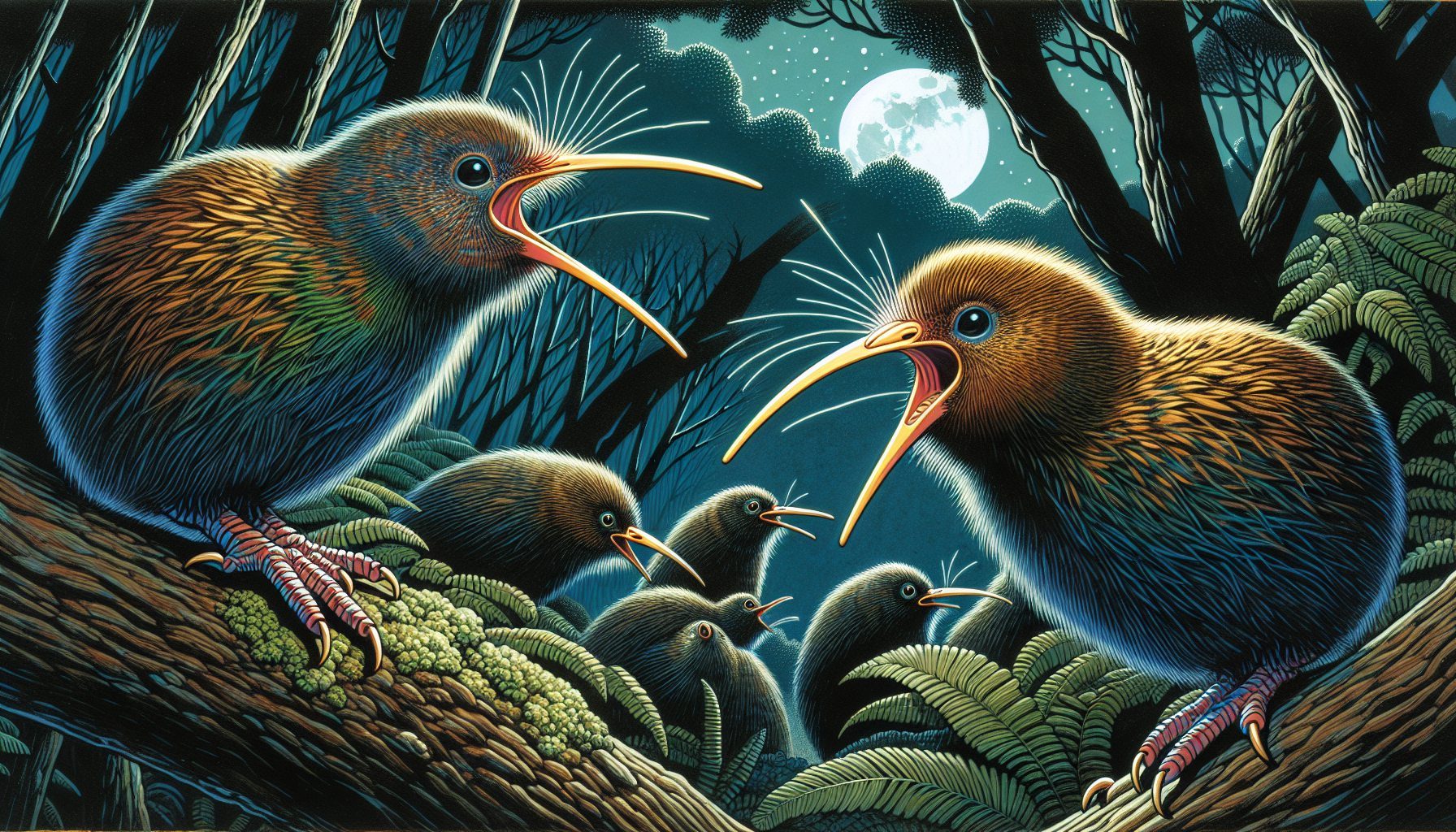
The forest resonates with various sounds as twilight sets in and the Kiwi embarks on nighttime activities. The male Kiwis emit a distinct ringing call composed of 8-25 notes, while females counter with a raspier call of 10-20. These calls are unique to each gender. They, along with various grunts, growls, and hisses, form an essential part of their communication system for territory delimitation and coordination during independent foraging.
Yet, these sounds go beyond mere functionality. They are crucial in shaping the social bonds among Kiwis as well. Kiwi pairs usually establish lifelong monogamous bonds, wherein, unusually amongst birds, larger females often assert dominance over their mate. Males fervently protect their territories, especially among little spotted and brown kiwi species, which is integral in courting potential partners.
Foraging and Dietary Preferences
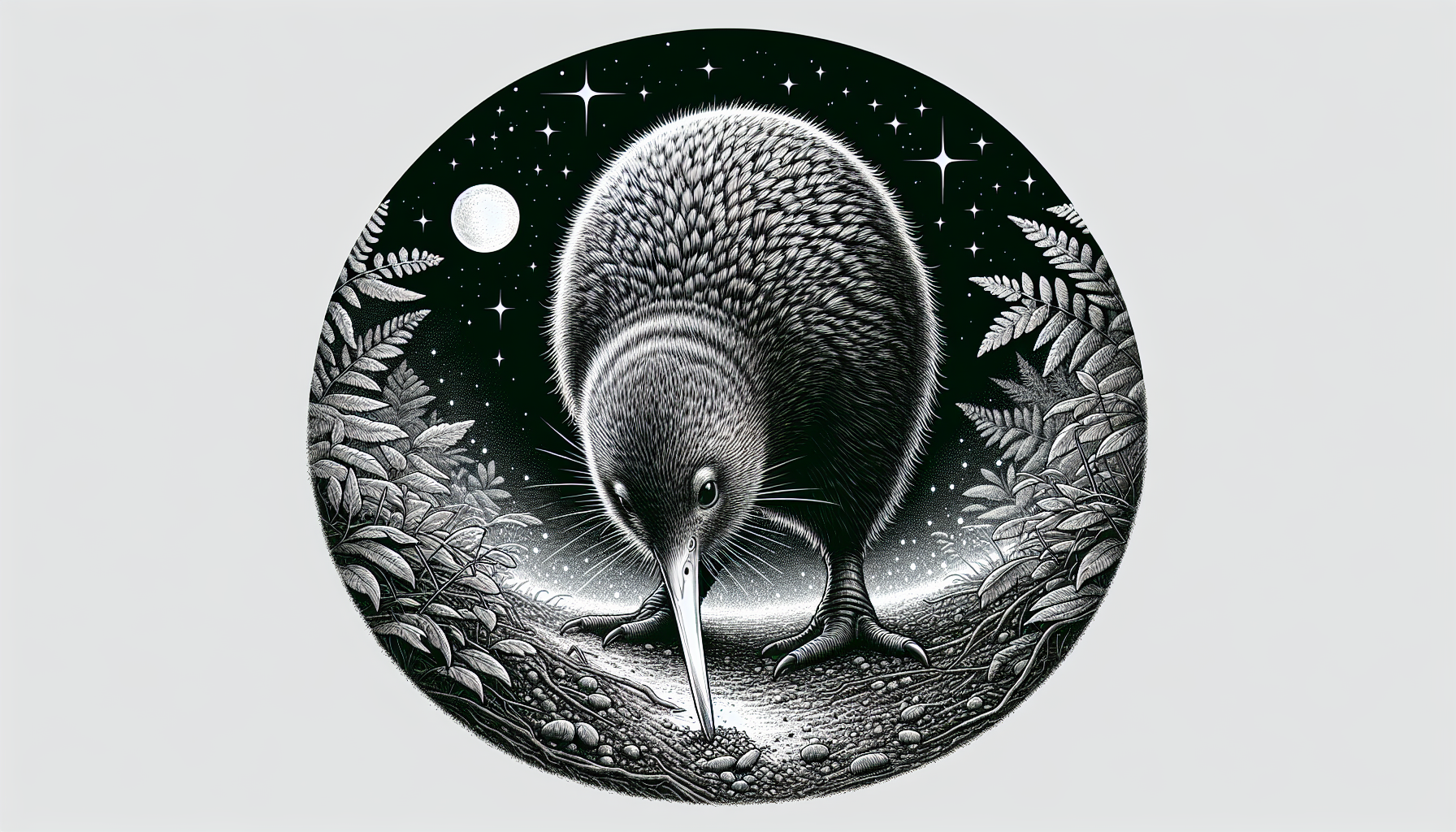
As dusk envelops the forest, Kiwis begin their nightly foraging endeavors, guided by an exceptional sense of smell to find sustenance. They deftly insert their beaks into the soil, utilizing nostrils at the bill’s end as olfactory guides to detect food. This unusual dependency on scent over sight is well-suited for their life under the cover of darkness. While rummaging through foliage and earth, Kiwis may produce a soft snuffling noise. They have a special valve behind their nostrils that keeps out dirt and other foreign matter during these excursions.
Regarding its dietary preferences, the brown Kiwi has quite an eclectic palate reflecting its various living environments.
It relishes earthworms.
Beetles form part of its diet.
Crayfish feature in its meals, too.
The bird enjoys consuming fruits and berries.
Native worms, which can reach lengths beyond 0.5 meters, are the favorite treats among these flightless birds. In addition, there are several improvements.
They consume various plant matter from indigenous flora, such as seeds and leaves, indicating remarkable dietary flexibility according to available foods in different habitats.
The versatility extends further. When residing in captivity, brown kiwis have been known to eat bracket fungi, frogs, and even fresh eels, revealing broad-ranging culinary tastes.
Nocturnal Lifestyle
Kiwis come to life as the day transitions into night, engaging in active foraging and using vocalizations after sunset to interact with their mates and establish territorial boundaries, especially during the late evening and early morning twilight.
These distinctive birds are equipped with substantial ears and diminutive eyes that aid them in moving through their habitat under darkness. Their highly developed sense of smell enhances their ability to flourish nocturnally, solidifying Kiwi’s status among some of the most extraordinary avian species.
Breeding and Offspring Development
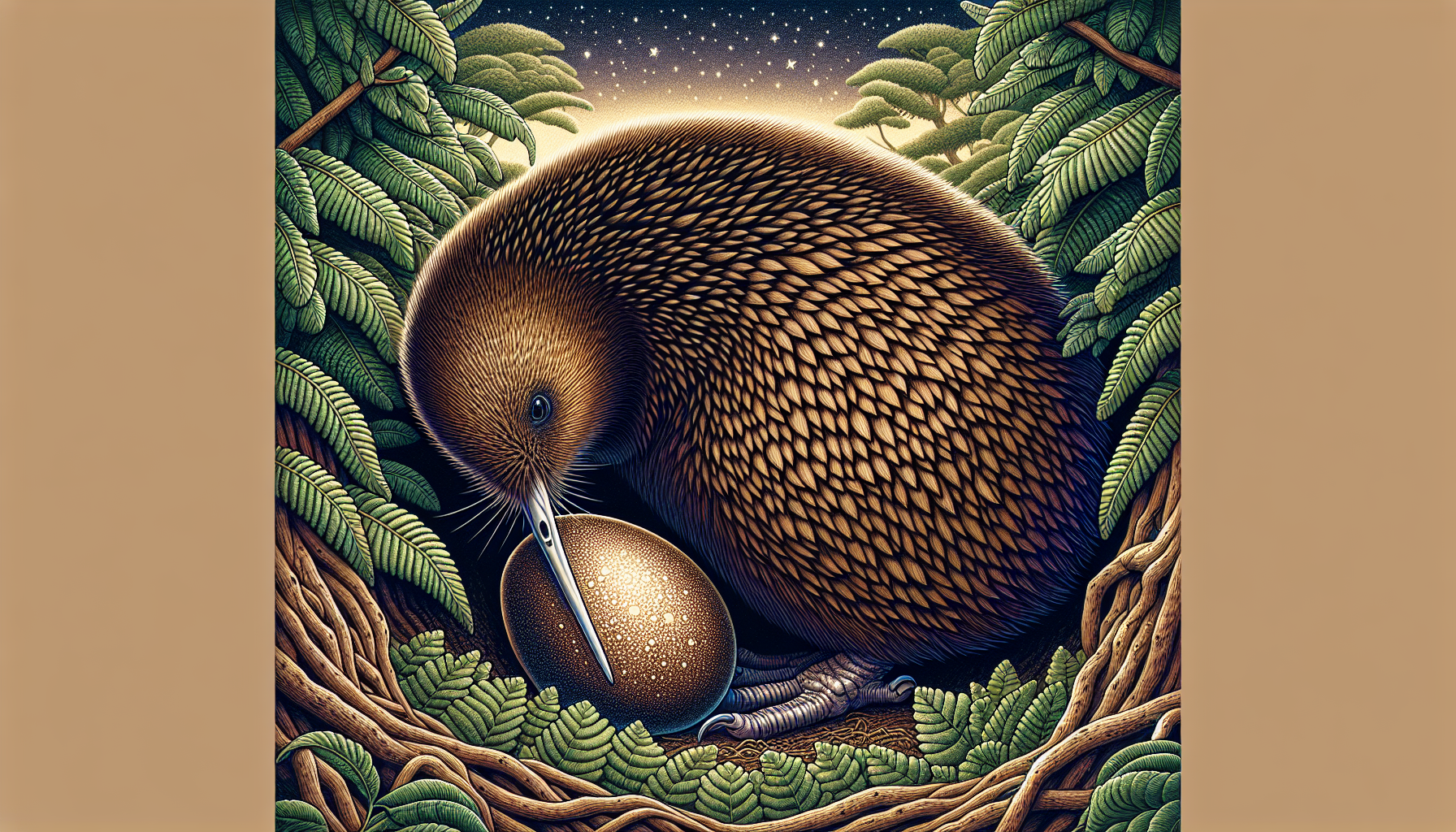
The mating rituals of the Kiwi are as captivating as the species itself. From June to March, their peak mating period, female kiwis produce remarkably large eggs compared to their size. These eggs can weigh almost a fifth of her mass. The male Kiwi assumes responsibility for incubating this solo egg throughout its development. With an incubation span ranging from 70-80 days, it stands out as one of the longest among avian species.
Kiwi chicks emerge from their shells, fully feathered and with eyes wide open. Initially, they depended on nutrition from the remnants of yolk in their eggs. As they mature over a period extending up to 20 months, these fledglings grow into adult-sized birds ready for independent life within nature’s fold. Female Kiwis usually begin laying at around three to five years old, while males may reach sexual maturity by just 18 months when reared under controlled conditions such as captivity.
Nevertheless, even with such early independence and rapid growth rates, young Kiwis remain vulnerable due to various threats impeding their chances at longevity after hatching.
High Chick Mortality Rate
A sad reality persists in the captivating realm of kiwi birds: the high death rate among young kiwi chicks. They face considerable risks from natural predators like stoats and cats. These threats are so severe that around 90% of these fledglings do not live beyond six months after hatching in their natural habitat. Predators account for 70% of these early fatalities.
The very existence of this unique bird hinges on the effectiveness of conservation measures. Should such initiatives fail, we could witness the disappearance of wild kiwis within just two generations. Smaller populations, particularly at risk, may suffer from environmental degradation, reduced genetic diversity, or crises such as disease outbreaks or surges in predator numbers—all highlighting why supporting and maintaining vigorous efforts toward conserving kiwis is critical.
Conservation Initiatives and Success Stories
The resilience of the kiwi bird population in New Zealand demonstrates the impact that concerted conservation measures can have. Through initiatives like Operation Nest Egg, survival rates for young kiwis have surged from a mere 5% to an encouraging 65%. In these endeavors, the National Kiwi Hatchery in Rotorua has successfully incubated individual kiwi eggs and over two thousand others gathered from sanctuaries and reserves throughout the North Island.
To bolster each unique species of kiwi birds, five specific sanctuaries were established by the Department of Conservation back in 2000. Notably, natural island refuges off the coast of New Zealand provide secure environments without predators for these birds. Similarly protective are mainland ‘ecological islands,’ which employ extensive predator-proof barriers and meticulous monitoring systems to ensure safe habitats for Kiwis. Such dedicated actions enabled two distinct species within the broader family of Kiwis to be reclassified from endangered status down to vulnerable as recently as 2017. This signifies noteworthy progress.
Areas, where intensive management against predators is conducted report signs indicating growth within local populations—a testament confirming such conservation techniques, are effective indeed. As emblematic representatives among other avian life forms impacted positively by preservation work across New Zealand ecosystems, it’s notable how broad-ranging benefits extend beyond just saving various types of Apterixes or ‘kiwis.’ This way, they inadvertently shield most other native birdlife on both islands – including juvenile specimens—which continues to enhance overall ecological health significantly because efforts began focusing originally on conserving chiefly iconic flightless inhabitants typically endemic only here inside scenic wilderness alongside coastal zones found predominantly throughout this beautiful southern land commonly known worldwide simply as “Zealand.”
Kiwi as a National Symbol
In New Zealand, the Kiwi bird is more than just an ecological presence. It’s a treasured icon of national pride. Held in high esteem by all communities within the country and especially valued as taonga—a sacred object—by the Mori people, this bird has become intricately woven into New Zealand’s cultural identity fabric. As a testament to their profound association with this emblematic avian species, residents of New Zealand affectionately refer to themselves as “Kiwis.”
Dating back to the 19th century as a military symbol for soldiers from New Zealand who also came to be called ‘Kiwis,’ the Kiwi bird serves not only on battlefields but also stands tall across different spheres, representing New Zealanders’ enduring commitment to protecting their distinct natural legacy. This influential symbol reflects a dedication to safeguarding and celebrating the nation’s exceptional biodiversity.
Human Impact and Cultural Connections
The Kiwi is not simply an extraordinary species. It embodies a connection to ancestral times, stands as an emblem of national identity and highlights the importance of preservation efforts. Within Maori culture, this relationship becomes especially significant. Kiwi feathers are used in crafting Korowai cloaks, which are significant as they represent ties to land and spirituality. High-status individuals receive kahukiwi (cloaks woven with kiwi feathers), symbolizing the bird’s high regard within Maori communities.
Inherent in these kiwi feathers is mana (a spiritual essence) that mirrors familial and tribal affiliations for those who don them, chosen with the utmost respect. Weaving these precious kiwi feathers into Korowai carries forward ancient customs that celebrate forebears while safeguarding the Maori cultural legacy. Regarded by the Maori people as taonga (treasured entities), the deep-seated sociocultural, spiritual affinity with this avian species is profound.
Acknowledgment of such relationships has been made formal through New Zealand’s Treaty of Waitangi settlement claims, which aim to fuse traditional wisdom into restoration activities geared towards aiding recovering populations threatened by extinction. The collaboration between community initiatives led by local indigenous groups contributes significantly to protecting habitats under integrated conservation projects where knowledge from generations past plays a vital role alongside collective communal actions. Maoris’ understanding of nature’s intricate web drives their reverence for all living things, shaping their dedication to ensure future survival and prosperity for the iconic bird known as the Kiwi by involving themselves holistically in its protection.
Summary
The journey through the life of a Kiwi bird has taken us from the moss-covered forest floors of New Zealand to the heart of conservation initiatives, threading a tale of survival, adaptation, and a nation’s commitment to preserving its unique heritage. We’ve uncovered the Kiwi’s distinctive features, delved into its nocturnal lifestyle, and learned about its unique breeding habits. We’ve also witnessed the harsh reality of Kiwi chick mortality rates and how human impact and cultural connections have shaped the Kiwi’s story.
The Kiwi bird, a symbol of New Zealand’s rich biodiversity, is more than just a species; it’s a testament to the harmony between humans and nature when we commit to conservation. As we continue to learn and adapt, let the Kiwi bird remind us of our duty to protect and preserve the natural world for generations.
Frequently Asked Questions
Why is the Kiwi bird so special?
Unlike most birds, the Kiwi is distinguished by its loose, fur-like feathers, trails at the tip of its beak, and a pronounced sense of smell.
This bird possesses dense bones replete with bone and robust legs. Its senses of smell and touch are highly refined compared to most other avian counterparts.
Are kiwis only found in New Zealand?
Kiwis can be located not just in New Zealand but also in specific areas of Australia.
How many kiwis birds are left?
There are approximately 70,000 wild kiwis in New Zealand, and thanks to several community-led conservation efforts, their population is increasing. Five distinct species of birds are present, and the North Island brown kiwi constitutes the largest group.
Why did the kiwi bird go extinct?
Due to predators, dwindling habitats, and isolated populations of Kiwis, these birds are susceptible to dangers such as invasive species and the degradation of their natural living spaces.
The destruction of their indigenous forest homes for human settlements and agricultural land has increased the Kiwi population’s reduction.
Why are kiwi birds unique?
The Kiwi is a remarkable bird distinguished by its long curved bill tipped with nostrils and shaggy plumage. It stands out as the tiniest member of the ratites, a family encompassing various large birds incapable of flight.
